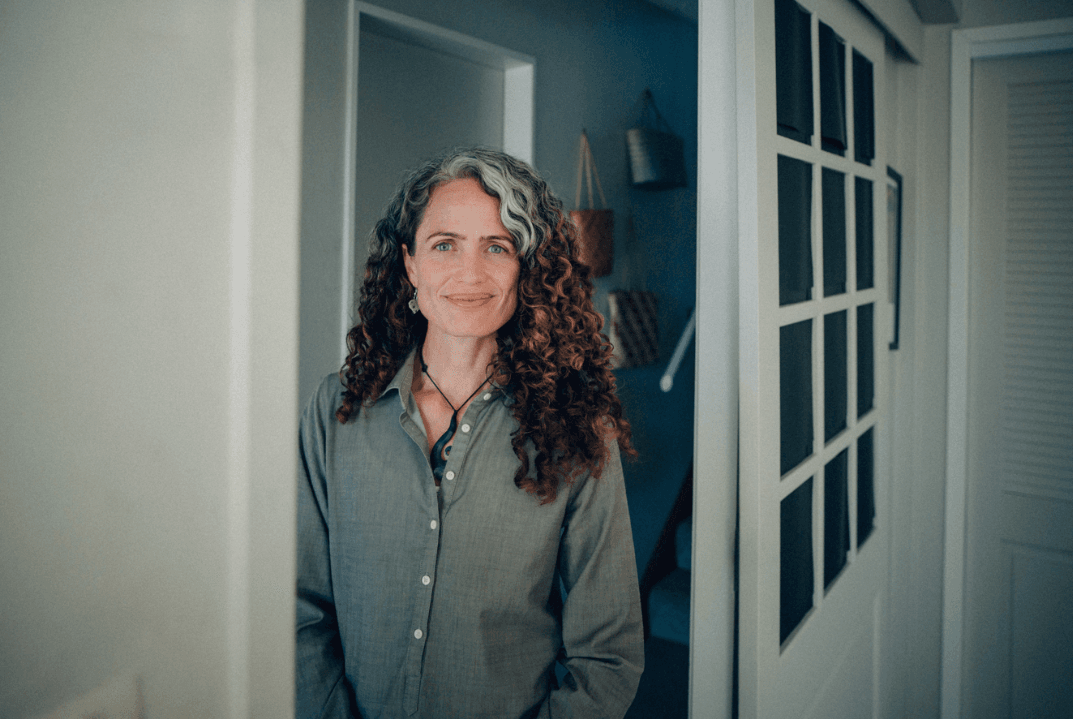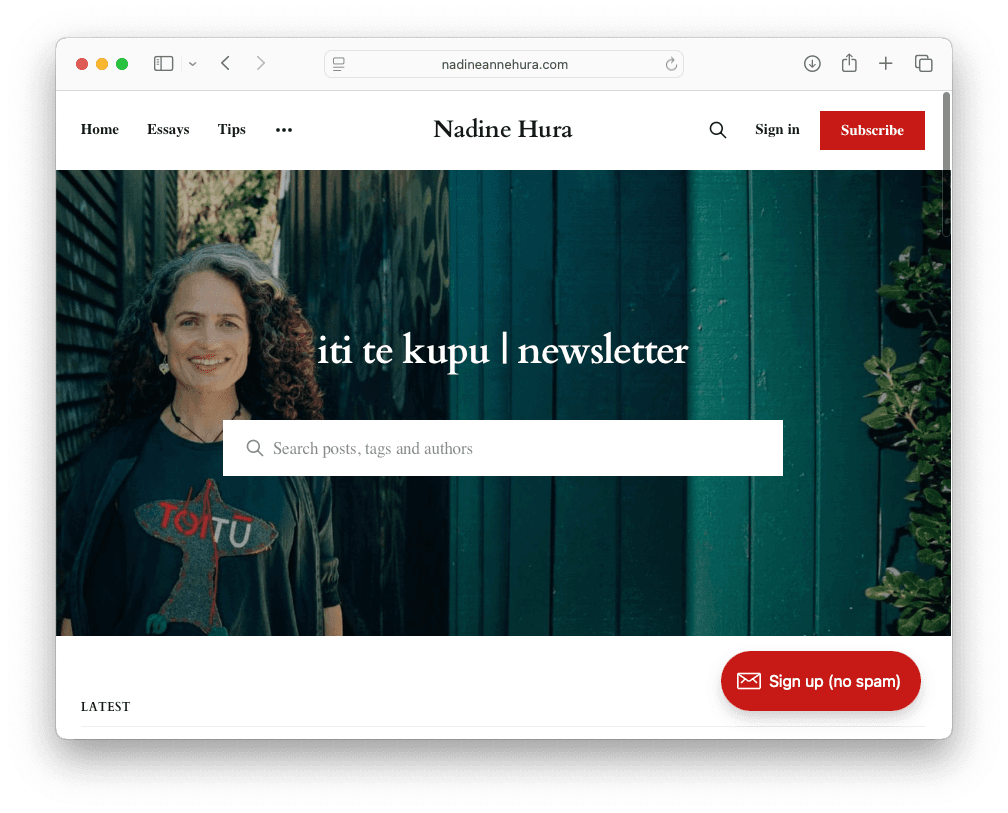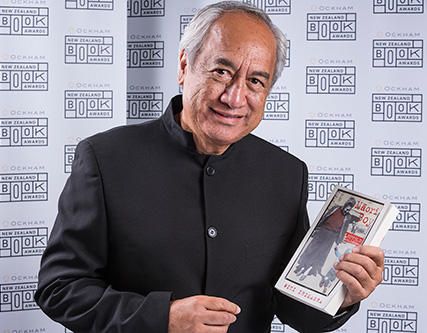Is it time you started a newsletter?
Unconventional tips that might actually be useful from Nadine Hura.

Nadine Hura is a poet, essayist, and weigher of things. She is the author of Slowing the Sun and has been self-publishing online for a decade. Hura sees Indigenous reclamation as creative practice. A different version of this article originally appeared in her newsletter.
I'm often asked for advice about starting a newsletter. My response varies a lot, because every artist’s personal motivation, background, skills and energy needs to be balanced within wider systems and structures.
I know from personal experience (10 years of sporadic blogging, three of them in newsletter format) most of the true rewards of online self-publishing are hardly recognised. For communities who have been shut out, silenced and gatekept, blogging offers a way not just to share our stories, but to affirm to each other that our stories matter enough to document and to witness. Newsletters can help us learn about our own creative practice, they can help us hone our skills, they offer challenges, while simultaneously reclaiming autonomous space for intentional connection. In other words, most of the rewards of writing a newsletter cannot be captured by dashboard analytics.
That said, online publishing also comes with pressure, risk and responsibility. Paywalls can offer a degree of protection and privacy, but this can put a barrier between you and the audience you want to reach. Conventional advice like “put your best work behind the paywall” is often counter-intuitive. If your best work is political advocacy, putting it behind the paywall where access is limited doesn't make a lot of sense. The paywall also doesn’t address (and arguably reinforces) the structural fuckery giving platforms to (and making money from) dangerous and toxic ideologies. In fact, a lot of the standard advice can be in direct conflict with your values. The system will always amplify and remunerate those who already have a voice and visibility, not just by design but by deliberate intent. Rarely is this structural advantage ever recognised and very few writers with access to a statistically significant audience routinely use their platform to amplify others (Emily Writes is an outlier in Aotearoa). People who evangelise that the newsletter is the great leveller capable of offering freedom and financial independence to every writer willing to work hard are either disingenuous or downright delusional.
Despite the complexities, publishing a newsletter is still one of the most valuable things I’ve ever done to support my creative practice. I’d recommend it to just about anyone. So here’s my top five pointers, together with a list of writers who’ve recently launched newsletters.
Authenticity over niche and schedule
It's often assumed that the main reason anyone would want to start a newsletter is to attract readers and convert them to paying subscribers. To be successful under this model, Reddit threads tell you to niche-down, publish high-quality content consistently, and be prepared to hustle. My advice is almost completely opposite. I’ve found that authenticity matters much more than consistency, and I don’t think it’s necessary or even advisable to restrict yourself to one theme or formula. A good structure is great if it works to motivate you, but you have to be able to sustain it over the long term. There’s no reason your niche can’t just be your own voice. Your niche can be your life and your unique take on events unfolding in real time. No-one else has that.
People are busy, though, so I agree that quality is important (but on your blog, you get to decide how you define quality). Your newsletter will be jostling alongside dozens of others in the average inbox, so be a rigorous editor. You don’t have to publish everything you write. Only about a third of my drafts ever make it to a subscriber’s inbox. Often that's because I run out of time to edit a piece before the spark goes out of it. But other times I don't end up publishing because the timing is wrong. Plenty of times I’ve just thought: nah, that's not good enough.
All this to say: a wide-ranging newsletter that arrives infrequently is not necessarily a sign of an unserious or undisciplined writer. Sometimes the opposite is true.
On motivation: Will a newsletter ignite (or crush) your creative practice?
I mentioned the tension and responsibility that comes with publishing a newsletter. I notice some feel this more than others. One of the reasons I’ve struggled to publish according to a schedule is that I’m always acutely aware of the wider context in which my writing is landing. I remember the first time I saw a graphic image from Gaza. I remember not being able to fathom that the horror might continue beyond two weeks. We are now approaching two years. How can anyone write about anything else? But what words can you find that haven’t already been screamed? And who is listening? More importantly, what are we doing?
Then there’s the multitude of local campaigns that need support. Having a platform with an audience can be a full time preoccupation. But if I look at the pieces I’ve published over the past two years, often in spite of overwhelming feelings of inadequacy, they’ve been words I needed to hear. I’ve documented tangihanga and loss – from Haimana’s Dad, to my friend Kath, to the formidable Renee. I wrote about the lovely few hours I shared with Ngāhuia Reedy before she unexpectedly passed away. I’ve written love stories. First person confessions by my alter-ego, Lois. Scraps of poetry and photographs documenting persistence and survival. I didn't even realise that there was a pattern to these pieces. I feel pretty sure that if it weren't for this newsletter, I would never have had the chance to let my 'niche' find me – as opposed to the other way around.
On head starts: Are you experienced or is this your first time publishing?

If you already have any kind of public profile, you will have a natural advantage when it comes to building an audience. Well known authors can turn an existing following into cash overnight. That’s literally the Substack pro model in a sentence. It’s a lot harder and less glamorous for everyone else. Sometimes dejecting. But success with a newsletter isn’t about numbers. For a lot of us, it’s about working on a draft all the way through to the thrilling moment you hit ‘publish’ (hūrō! another fragment that might never have been written!)
It's also about witnessing a life – your own and those around you – as it is lived, in real time. The beauty of that shines through only with the accumulation of posts. The real understated value of newsletters, I think, is not in a single brilliant piece of writing that blows up the internet, but in the longer narrative that evolves through seasons and cycles over years. Readers who stick with you through those seasons are rarely as valued as the stats that eagerly tell you how many new subscribers you attracted in the last month.
If a newsletter will be your first time publishing, enjoy it. It's an important ritual of writing. Having a blog gives you an opportunity to test out how it feels. When someone else is in control, publishing can be anxiety-inducing. Keeping your writing separate from publishing is how you best hear, document, and protect the authenticity of your own voice. Publishing requires you to think about audience, and that's a huge responsibility, but if you internalise that pressure too soon or too heavily you can end up missing the surprise of writing that is unselfconscious and permission-giving (I've talked a bit about that here and here).
The beautiful thing about a blog is that you can un-publish something in the middle of the night if you wake up and change your mind. You can’t do that with something sold or signed away. If you put the thoughts out on Facebook, even worse.
If you’re an experienced writer, enjoy the liberation. Give yourself permission to break your own rules and experiment. Have fun. Play. You’re your own editor! You can publish that random piece about your lover written in the voice of your alter ego that otherwise would never have found an outlet. Not only is the freedom you can give yourself generous, it's also likely to produce something unique and interesting.
On hustling: Can you really make bank?
Ten years ago, the idea that people would pay you to be allowed to read your blog would have been the stuff of a Black Mirror episode. Who remembers blogger idol? Ten years ago, the idea of putting any kind of barrier between your words and a mildly interested pair of eyes would have been inconceivable.
Part of the reason I left Substack was because its heavy-handed sign-up tactics didn’t gel with me. But having a paywall can provide important protections. You can reveal more, be more honest. I give away as many complimentary subs as I receive in paid subs, and the majority of what I publish goes out to everyone for free because it feels right to me. I don't think of the paywall as a transaction, I think of it as an exchange of something that we both value.
If you’re gonna go paid, I recommend a price point that is affordable to the audience you most want to connect with. In New Zealand, we just don’t have the population to support all writers who want a room with a view. I’m shit at maths, but I’m good at judging workload, and I know how long it takes to write and research and edit. Anybody working full time as a writer in this country is working bloody hard. I’m not saying you can’t make a living, I’m saying it’s not a magic trick and it's definitely not a retirement plan .
My paid sub is $50 per year. The average seems to be $70-$80. Unless your newsletter is your full time gig or only income, I think a more accessible price means there might be more resource to go around. There’s a limit to the number of publications a single person can realistically support, after all.
On Platforms: Substack, Ghost, Beehiv, Medium…..?

There’s a reason Substack has been so successful in the paid newsletter business. It’s easy to launch, free to use, and the platform is geared around growth. For some communities, those first two can mean the difference between publishing or not. It’s hard enough to overcome the self-doubt, then to carve out the time to actually write, let alone having to pay for the privilege to publish. But the old adage ‘when something’s free, you’re the product’ is true. Substack is riddled with built-in, barely-concealed tricks to capture email addresses and pressure readers to pay. From Substack’s perspective, all this "hustling" on your behalf makes sense. When you profit, they profit – to the tune of 10%. That’s not insignificant when you’re tapping into dominant narratives.
Which brings us to the cons: Substack markets itself as a platform for “independent voices” which is code for Substack doesn’t do content moderation. The same services you benefit from benefit all writers, including those peddling hate speech and mis and disinformation. Substack’s staunchly defended arrogance made it easier to leave, but there were other things to gain. My blog is now hosted on Ghost, a non-profit open-source platform with a much more transparent and ethical business model. It isn’t free, but it offers a lot more, including the ability to customise your design and integrate a shopping cart and other standard web features. The thing I like the most about Ghost is that it offers an additional layer of privacy. Unlike Substack, which only allows you to publish public or paywalled posts, Ghost allows you to publish free posts to signed-in members only. This means that your audience is visible, and you have another layer of protection, in theory at least, against AI accessing your content to train LLM (Language Learning Models).
Beehiv is another popular newsletter option, and while it isn’t as comprehensive as Ghost, it’s at least free to get started and try out. Squarespace and Wordpress can also be adapted to integrate a newsletter, with Patreon another well used platform for creators. As an outlier, I also highly recommend Medium, especially for people who just want to write (even anonymously) and not think or worry too much about promotion or marketing.
Newsletter recommendations
Below are some links to writers who’ve recently launched newsletters so you can see who else is out there. One thing I think it's really important to reiterate is that if you want people to read your blog, you should read others too. It's not just good practice in terms of learning, it's how we affirm each other as part of a community who values each other's voices and stories. It's this natural reciprocity within communities that contributes to our collective abundance.

Witi Ihimaera - What a gift to have insight into the mind and life of someone who’s contributed so much to the landscape of literature in Aotearoa, carving space for new voices every. single. kaupapa.
The wonderful thinker, poet and activist Grace Tualauleilei. Yes. Let’s go, Grace!
My friend and author Helen Lehndorf, writing about foraging, simplicity, mutual aid, re-commoning, permaculture and food resilience.
My Taraheke sister, Cassandra Barnett (Māmā writer artivist philosopher / shapeshifting indiginaut / ready for the next cycle) who I've been encouraging to start a blog for at least two years. If you relate to this steady caution and have been waiting a similar length of time for a sign, you must subscribe!
The multi-talented crafter/maker Francoise Danoy, with occasional words by her Māmā. There seems to be nothing that Frenchie can’t turn her hand to, and writing is just another skill. But she’s always humble, always generous, always makes you feel like you could do that too.
Writer, poet, muser and author of The Seasonwife, Saige England. The title “Saigeisms” is the kind of blog name you wish your name lent itself to, a title you could spend six months frowning into the distance trying to come up with.
Although she’s only posted twice in almost a year, Nadia Abu-Shanab’s writing is gold, and if I have anything to do with it, her fragments are for sure destined for the pages of a physical book one day.
A beautiful meditative first blog by Vanessa Ellingham, writing towards Aotearoa from Berlin, on a journey of indigenous reclamation in which I related to everything (and feels very aligned to this post). I'm really looking forward to this one.
Cameron McCausland-Taylor who I honestly feel stoked to know, and whose passion and nerdy curiosity about eco-writing reminds me of me. Her poetry and her advocacy for the protection of tangaroa, as well as her commitment to posting once a week, is awesome. When she documented her first in the wild whale sighting I swear I felt like I was there.
I was introduced to Nicole Haerewa when I put this call out to new bloggers and I had immediate big feelings. Look at these photographs! Nicole writes that she’s hoping to reduce the perceived degrees of separation between people and the environment, inviting a view of indigenous Aotearoa through her camera lens. Absolutelyfrickenstunning.

A blog from Wairoa?!! Get me to it! Author Marino Harker-Smith’s writes about community connections, events, profiles and the highs and lows of moving from the city to provincial rural Tairāwhiti New Zealand. I’ve been to Wairoa and even written about Wairoa. There’s something about small towns… I immediately want to start the Titahi Bay Bulletin.
Chronically burnt out (but hopeful). This is Cassie Hart, a great friend, amazing writer, supportive editor, will go out of her way to help anyone with their writing. Cass is so knowledgeable about publishing across the entire industry and I didn’t know Cassie had a blog til now - e hoa, so much to catch up on!
Leilani Tamu, who is doing beautiful in-depth interviews with local indigenous authors - how generous and needed.
Megan Dunn, writing irreverently about art and life with her trademark humour, but also with a tenderness that might just rip out your heart while it’s still laughing - e.g. Mum-rabilia, the best sweet thing I’ve read all year.
Author, playwright and game writer Claire Hiria Dunning, who also hosts the internationally popular #pretendpanel on Bluesky - and like me, has come through the very successful Te Papa Tupu programme (where Cassie and I met).
An old friend: Hiringa Maakiwhara, who's just launched this week, is down in the grit exploring the domestic and the personal and the spiritual as she makes her way towards the light and healing - a lot of wāhine will relate.
A new friend: Graham Hughes, who writes McKinley Road Creatives. Graham and I have so much in common it's crazy. He regularly inspires me with his meanderings and tinkerings, whether it be metal, fabric, political rant or thought. Still hoping to meet in real life one day.
Another mate! Melody Thomas, who I worked with on the Ahi Kaa podcast. Melody is writing about obsessions, but really, it’s Melody voice that is the obsession. She's brilliant. She and Kirsty Johnstone produced the Good Sex Project podcast, which I am sure I’m the unofficial ambassador for.
Last one: Tusiata Avia. Also awhi'd into the newsletter world by Emily Writes. Tusiata’s blogs are always worth waiting for - especially this one: Some hope in dark times.